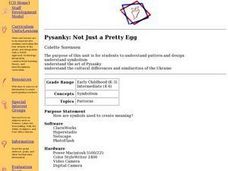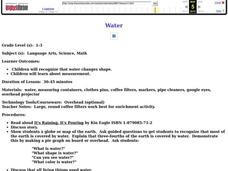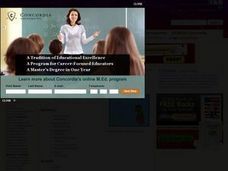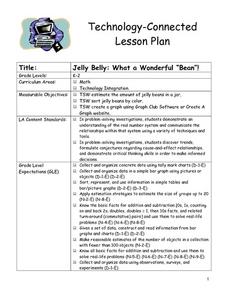Curated OER
Robotics
learners identify and research robots in various roles in society, and create robotic arms and multimedia presentation based on their findings.
Curated OER
Look at Those Leaves!
Students research tree leaves. In this tree leaves lesson, students observe, measure, and sort tree leaves. Students examine leaves individually, in groups, and in relationship to the entire tree.
Curated OER
Introduction to Seeds
Students investigate how to plant a seed. In this gardening lesson, students listen to the book I'm a Seed and research the materials needed to plant a seed. Students present the information they found.
Curated OER
Number Books
Students construct a book to illustrate number concepts. They write their numbers on a sheet of paper. Students in grade 1 discuss counting to 100 by different numbers. Pupils in grades (2-4) write basic addition or subtraction story...
Curated OER
Pysanky: Not Just a Pretty Egg
Students examine the art of Pysanky. Using the Internet, they identify the cultural similarities and differences between the United States and the Ukraine. Using Pysanky's art, they discover the symbolism he used in his artwork and...
Curated OER
Why Plants Are Important to Us
First graders explore plant life. In this plant lesson, 1st graders examine various plant life and categorize them. Students graph their data and make journal entries regarding their work.
Curated OER
Subtraction Action!
Students work together in teams to create subtraction problems based on the numbers their teacher gives them. They solve the problem in question. They complete timed tests to practice their skills more.
Curated OER
Beyond The Earth Part I
Students explore the solar system. In this space science lesson plan, students take notes on the solar system provided by their instructors. Students then collaborate to design a computer-generated drawing of the solar system.
Curated OER
Water
Learners complete activities to examine the properties of water. In this water science lesson, students read a book about water's forms and study a map or globe of the Earth to investigate water. Learners discuss living things that need...
Curated OER
Guess What I Came From
First graders examine items made from plants. In this plant lesson, 1st graders read Plants Feed on Sunlight and view a PowerPoint presentation regarding plant growth. Students examine products that are made from plants and draw pictures...
Curated OER
Yummy for my tummy!
First graders read the story Tops and Bottoms and identify vegetables that are eaten from the stem, root, and leaf of a plant. In this vegetables lesson plan, 1st graders learn vocabulary about different vegetable parts and write journal...
Curated OER
An Introduction to Jan Brett
Students explore the concept of Jan Brett. In this author study lesson, students are introduced to several Jan Brett books with visuals, listening centers, and video. Students browse the internet in search of information...
Curated OER
We Are Alike, We Are Different:A Focus on Japan
First graders develop a connection with students in a first grade classroom in Japan. They begin to develop a curiosity about Japan--the landscape, the people, and their culture, while developing an understanding of the Five Themes of...
Curated OER
What We Need
First graders identify basic needs of plants. In this plant growth lesson, 1st graders observe types of plants and review the parts of a plant as well as the development of a seed. Students review related vocabulary and read The...
Curated OER
Gingerbread Baby
Students explore gingerbread stories. In this poetry lesson, students read the folk tale "The Gingerbread Man" as well as Gingerbread Baby by Jan Brett and identify rhyming words. Students also make art projects, dramatize the stories,...
Curated OER
20 Field Day Activities Any Kid Can Do (And Do Well!)
Students participate in activities in which they practice their physical skills. They work together on some of the activities to practice mental skills as well. They show their team spirit as the winners are announced.
Curated OER
Chucky Chickadee: Bird and Breakfast Meet the Winter Friends
Students compare and contrast the attributes of winter birds. In this winter bird lesson, students examine the physical attributes of Black-capped Chickadees, Cardinals, Blue Jays, Flickers, Juncos, Nuthatches, and Tufted Titmouses as...
Curated OER
Playing Historical Detective: Great Grandmother's Dress and Other Clues to the Life and Times of Annie Steel
Students draw conclusions about an mystery person based on documents and artifacts provided. In this drawing conclusions activity, students become detectives by reading and analyzing evidence provided. This activity includes...
Curated OER
Do Different Colors Absorb Heat Better?
Pupils work together to test how the color of a material affects how much heat it absorbs. They make predictions and take notes on their observations. They discover how engineers use this type of information.
Curated OER
Philanthropic Literature: Give a cookie
Students read a book to discover the importance of sharing. They predict what will happen in the story. Students use manipulatives to model the story problem. Students follow instructions, measure ingredients, and make cookies.
Curated OER
Our Daily Five
Students explore the food pyramid through a class discussion, hands-on experience with food items, and a floor game that helps them to identify the food group involved. Lesson extensions include the use of play money, art, and dance.
Curated OER
Graphing Favorite Holidays
Students create spreadsheets and bar graphs based on results of survey of favorite holidays.
Curated OER
Jelly Belly: What a Wonderful "Bean"!
Students explore how jelly beans are produced. They discuss the origins of the jelly bean and view a video about how jelly beans are prepared, tested, shaped, finished, and shipped and estimate the amount of jelly beans in a jar and sort...
Curated OER
Grand Grocery Graphs
Students experience creating their own graphs on graph paper and the computer program "Graph Club." They approach this task by utilizing food as their primary source for the activities. In addition, they interact with their peers as they...























